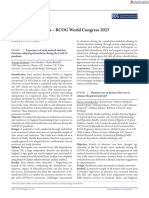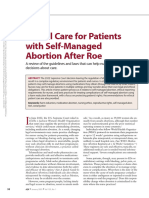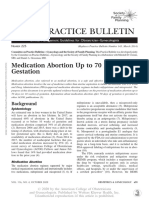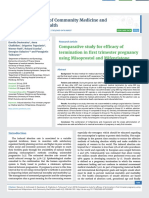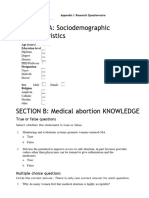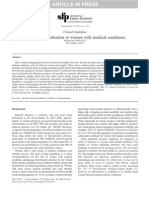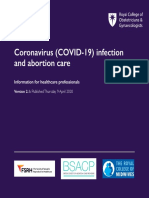Kohn 2019
Uploaded by
Elita RahmaKohn 2019
Uploaded by
Elita RahmaAbortion: Original Research
Medication Abortion Provided Through
Telemedicine in Four U.S. States
Julia E. Kohn, PhD, MPA, Jennifer L. Snow, MSc, Hannah R. Simons, DrPH, Jane W. Seymour, MPH,
Terri-Ann Thompson, PhD, and Daniel Grossman, MD
OBJECTIVE: To assess outcomes of medication abortion telemedicine and standard groups, we performed logistic
provided through telemedicine compared with standard regression accounting for gestational age and health
medication abortion at Planned Parenthood health center clustering.
centers in four U.S. states. RESULTS: A total of 5,952 patients underwent medica-
METHODS: In this retrospective cohort study, we ana- tion abortion (738 telemedicine and 5,214 standard).
lyzed electronic health records for patients receiving Mean gestational age was 50.4 days for telemedicine
telemedicine compared with standard medication abor- patients compared with 48.9 days for standard patients
tion at 26 health centers in Alaska, Idaho, Nevada, and (prevalence ratio 1.02; 95% CI 1.00–1.03). We had out-
Washington from April 2017 to March 2018. All patients come data for 4,456 (74.9%) patients; follow-up within 45
had on-site ultrasound scans, laboratory testing, and days of abortion was lower among telemedicine patients
counseling and provided informed consent before meet- (60.3%) than standard patients (76.9%) (prevalence ratio
ing with the clinician. Telemedicine patients met with 0.83; 95% CI 0.78–0.88). Among patients with follow-up
a clinician by secure videoconference platform; standard data, ongoing pregnancy was less common among tele-
patients met with a clinician in person. We also reviewed medicine patients (2/445, 0.5%) than standard patients
adverse event reports submitted during this period. (71/4,011, 1.8%) (adjusted odds ratio [OR] 0.23; 95% CI
Study outcomes included ongoing pregnancy, receipt of 0.14–0.39). Aspiration procedures were less common
or referral for aspiration procedure, and clinically signif- among telemedicine patients (6/445, 1.4%) than standard
icant adverse events. To compare outcomes between the patients (182/4,011, 4.5%) (adjusted OR 0.28; 95% CI
0.17–0.46). Fewer than 1% of patients in each group re-
From the Planned Parenthood Federation of America, New York, New York; Ibis ported clinically significant adverse events. No deaths
Reproductive Health, Cambridge, Massachusetts; and Advancing New Standards were reported.
in Reproductive Health (ANSIRH), Bixby Center for Global Reproductive
Health, Department of Obstetrics, Gynecology and Reproductive Sciences, CONCLUSION: Findings from this study conducted
University of California, San Francisco, Oakland, California. across geographically diverse settings support existing
Supported by a private grant from the Susan T. Buffett Foundation. The funder evidence that outcomes for medication abortion pro-
had no role in the study design, implementation, analysis, manuscript prepara- vided through telemedicine are comparable with stan-
tion, or the decision to submit for publication.
dard provision of medication abortion. Differences in
The authors thank all of the Planned Parenthood providers and health center staff
observed outcomes may be due to differential follow-up
who worked to launch and provide telemedicine services and contributed data to
this study; affiliate staff Jaylyn Bunning, Kristina Tocce, Caitlin Clark, Stepha- between groups.
nie Roberts-Dillanes, and Mary Stark for their review of this manuscript; and the (Obstet Gynecol 2019;134:343–50)
PPFA staff who championed this initiative, especially Deborah VanDerhei, Dana
DOI: 10.1097/AOG.0000000000003357
Northcraft, and Kelley Wall.
T
Each author has confirmed compliance with the journal’s requirements for
authorship.
here is consensus within the medical and scientific
Corresponding author: Julia E. Kohn, PhD, MPA, Planned Parenthood
communities that induced abortion is a safe and
Federation of America, New York, NY; email: julia.kohn@ppfa.org. effective health care procedure. A 2018 report by the
Financial Disclosure National Academies of Sciences, Engineering, and
Dr. Grossman has received consulting payments from Planned Parenthood Medicine found that abortion—including medication
Federation of America for work related to telemedicine for medication abortion.
The other authors did not report any potential conflicts of interest.
abortion—is a safe and effective way to end a preg-
nancy.1 The report also demonstrates that various reg-
© 2019 by the American College of Obstetricians and Gynecologists. Published
by Wolters Kluwer Health, Inc. All rights reserved. ulatory and legislative restrictions on abortion
ISSN: 0029-7844/19 provision create unequal and inadequate access to
VOL. 134, NO. 2, AUGUST 2019 OBSTETRICS & GYNECOLOGY 343
© 2019 by the American College of Obstetricians
and Gynecologists. Published by Wolters Kluwer Health, Inc.
Unauthorized reproduction of this article is prohibited.
abortion in areas of the United States, particularly in adverse events—compared with outcomes of standard
the South and Midwest.1–3 A recent study that repli- medication abortion at Planned Parenthood health
cated a person’s experience searching for an abortion centers in four U.S. states.
provider online found that there are 27 U.S. cities of
more than 100,000 people that are “abortion de-
serts”—the city is more than 100 miles from the closest METHODS
abortion provider.4 Outside of large cities, access to In 2016, Planned Parenthood Federation of America
abortion is worse—90% of all U.S. counties lack an launched a program to expand provision of tele-
abortion provider.5 Limited access to abortion impo- medicine for medication abortion to increase access to
ses medical, social, and economic burdens on people abortion in the United States. Medication abortion
seeking abortion and often means they must wait or involves the provision of two medications: mifepris-
travel long distances to obtain abortion care.6–9 tone and misoprostol. Currently, the U.S. Food and
One strategy to address barriers and increase Drug Administration requires that mifepristone be
access to abortion is the provision of medication provided only in clinics, hospitals, or medical offices
abortion through telemedicine. Telemedicine is under the supervision of a certified prescriber. At
a growing field in health care more broadly,10–13 Planned Parenthood, patients seeking medication
and medication abortion is a natural application for abortion visit a health center and receive in-person
this care delivery model because it is a simple treat- care from staff, including ultrasound scans, laboratory
ment requiring minimal hands-on assessment. Tele- testing, education, and counseling, and provide
medicine may be especially useful in states with informed consent before meeting with the clinician.
physician-only laws, which require that a patient meet At health centers with an available clinician able to
with a physician rather than an advanced practice provide medication abortion, patients meet with the
clinician (eg, nurse practitioner or physician’s assis- clinician in person. We refer to this as standard
tant) to obtain an abortion (whether by medication medication abortion. At participating health centers
or aspiration). In remote locations where it is difficult without an available clinician able to provide medi-
to maintain physician staffing, telemedicine may allow cation abortion on-site, the patient meets with a clini-
patients to receive care sooner and at a health center cian virtually using a secure videoconference platform
closer to home. and takes the mifepristone in view of the on-screen
In 2008, Planned Parenthood of the Heartland clinician. We refer to this as telemedicine medication
launched telemedicine for medication abortion in abortion. For both groups, misoprostol, taken up to 48
Iowa. An evaluation of this program using clinic- hours later, is either dispensed at the health center or
and patient-reported data found that telemedicine for prescribed along with other auxiliary medications.
medication abortion was comparably effective with As with standard medication abortion, telemedi-
services provided through standard care.14 A subse- cine patients are instructed to complete follow-up
quent analysis of adverse events related to medication evaluation within 1–2 weeks by ultrasound scan or
abortion across Iowa over 7 years also found that tele- serial human chorionic gonadotropin (hCG) testing
medicine was comparable with standard services.15 at the health center or an outside facility. In the event
Surveys and interviews conducted with patients dem- of an unsuccessful medication abortion, patients can
onstrated comparable and high satisfaction with both receive an aspiration procedure within the provider
service delivery models.14 Health care providers also network or at an outside facility, depending on service
found telemedicine for medication abortion to be availability or patient preference. The present study is
highly acceptable, reporting that it facilitated patient- limited to four states where Planned Parenthood
centered care by allowing patients to be seen sooner health centers offered telemedicine for medication
or closer to home.16 abortion between 2016 and 2018. In this retrospective
Despite this strong evidence, published research cohort study, we compared outcomes for patients
about outcomes of telemedicine for medication abor- receiving telemedicine medication abortion with
tion in the United States is currently limited to Iowa. those for patients receiving standard medication abor-
The present study expands the evidence base to four tion at Planned Parenthood health centers in these
additional states now offering telemedicine for med- same four states. Study outcomes included occurrence
ication abortion services (Alaska, Idaho, Nevada, and of ongoing pregnancy, receipt of or referral for an
Washington). We sought to assess outcomes of tele- aspiration procedure, and clinically significant
medicine medication abortion—including ongoing adverse events. This retrospective analysis of rou-
pregnancy, receipt of or referral for aspiration, and tinely collected administrative data was reviewed
344 Kohn et al Medication Abortion Through Telemedicine OBSTETRICS & GYNECOLOGY
© 2019 by the American College of Obstetricians
and Gynecologists. Published by Wolters Kluwer Health, Inc.
Unauthorized reproduction of this article is prohibited.
and approved by the Allendale Investigational patient’s chart. We therefore can assess abortion out-
Review Board. comes only for those patients who returned to, or
We assessed abortion outcomes for a convenience otherwise had communication with, the health center
sample of all patients undergoing medication abortion within 45 days of their medication abortion.
presenting at participating health centers in Alaska, We identified ongoing pregnancy based on re-
Idaho, Nevada, and Washington for 1 full year: April sults of all available follow-up testing, including
2017 through March 2018. We used administrative ultrasound scans and serial hCG tests. We determined
data from participating centers’ electronic health ongoing pregnancy based on the provider’s docu-
record (EHR) systems to assess patient characteristics mented interpretation of ultrasound images indicating
and abortion outcomes related to effectiveness, an ongoing pregnancy—defined by the presence of
including ongoing pregnancy (ie, presence of fetal car- fetal cardiac activity or, in the case of hCG follow-
diac activity or, in the case of hCG follow-up, any up, any result indicating a drop of less than 80%
result indicating a drop of less than 80% within 2 within 2 weeks of mifepristone administration, per
weeks of mifepristone administration) and aspiration protocol.
procedure. We identified patients undergoing medica- We identified a patient’s receipt of an aspiration
tion abortion using the Current Procedural Terminol- procedure based on the presence of a corresponding
ogy (CPT) code for mifepristone (S0190).17 CPT code (59840, 59841, 59812) within 45 days of
We worked with participating health centers to mifepristone administration. In addition, we exam-
extract encounter-level, partially de-identified patient ined an open-text encounter remarks field to identify
data entered into the systems at the time of service as any other documentation of an aspiration procedure
part of routine clinical charting. We obtained all within 45 days. For two sites where aspiration was not
encounters for patients on the day of their medication available at a local Planned Parenthood health center,
abortion when mifepristone was provided as well as we identified referral to an external provider for inter-
any subsequent visit or communication with the vention using a specific structured field in the medi-
health care network within 45 days of receiving cation abortion follow-up EHR template. Finally, we
mifepristone if recorded in the patient’s chart (includ- reviewed adverse event reports (discussed in greater
ing follow-up hCG results obtained elsewhere if docu- detail below) submitted by participating health centers
mented in specific fields in the chart). We included to determine whether any ongoing pregnancies or
data from the full 45-day follow-up window for all aspiration procedures were reported for patients
patients; thus, some follow-up encounters occurred who did not return to the health center within 45 days
after March 2018. or did not have other documentation of an ongoing
All participating health centers included in this pregnancy or aspiration procedure at follow-up
analysis used similar EHR templates, though data are encounters.
not shared across systems. Thus, we harmonized The unit of analysis was unique abortion episode
extracted reports to analyze comparable outcomes rather than unique patient. Thus, patients who may
from each health center. We reviewed data extracts in have had multiple medication abortion episodes
consultation with participating centers; site-specific within the study period are included multiple times
codes or terminology were discussed and resolved in the analysis if mifepristone CPT codes occur more
with staff before final coding. We then aggregated the than 45 days apart (ie, distinct abortion episodes). We
harmonized reports, which included data for patients compared abortion effectiveness outcomes using
seen at 26 participating health centers across four bivariate and multivariate analyses, with the exposure
states. We identified telemedicine for medication of interest being receipt of medication abortion
abortion visits based on specific EHR template fields through telemedicine compared with standard medi-
indicating that the visit was completed through tele- cation abortion. We included gestational age as
medicine; these structured data fields were tested a covariate given evidence from the literature that
before the launch of telemedicine services at partici- prevalence of ongoing pregnancy increases with
pating health centers. advanced gestational age.18 To account for the non-
We assessed ongoing pregnancy and receipt of or independence of observations within health centers,
referral for an aspiration procedure after medication we adjusted the standard error using the Stata vce
abortion. We determined whether these outcomes option.
occurred based on data reported in the EHR from We conducted sensitivity analyses to address
patients’ follow-up visits to, or communications with, missing outcomes for patients who did not follow up
the health center network if documented in the with the health center by applying published rates of
VOL. 134, NO. 2, AUGUST 2019 Kohn et al Medication Abortion Through Telemedicine 345
© 2019 by the American College of Obstetricians
and Gynecologists. Published by Wolters Kluwer Health, Inc.
Unauthorized reproduction of this article is prohibited.
ongoing pregnancy (0.8%, range 0–2.6%) and aspira- outpatient treatment of incomplete abortion was not
tion after medication abortion for any reason (3.3%, reported as an adverse event. Similarly, cases of
range 1.7–9.0%) from a systematic review18 to patients ectopic pregnancy were captured only if the patient
who were lost-to-follow-up. We then calculated esti- required hospitalization, surgery, blood transfusion,
mated rates of ongoing pregnancy and aspiration pro- or treatment in the ED. It is worth noting that Planned
cedures for the full population, including those Parenthood health centers have standard protocols for
without follow-up data, and compared these rates with initiating and managing medication abortion for
those for the population of patients with documented pregnancies of unknown location.
medication abortion outcomes. Individual patients may have experienced more
As part of the Planned Parenthood–affiliated than one clinically significant adverse event, all of
network, health centers submit incident reports for which are reported here if known. For example,
adverse events related to medication abortions for the a patient who underwent surgery and also received
purposes of safety monitoring and quality improve- a blood transfusion would be counted in each of these
ment. The following types of events are reported categories but would be counted as a single case of
through a centralized system: ongoing pregnancy, having experienced “any major adverse event.” We
complications associated with ectopic pregnancy, calculated the frequency of any event and event type
hospitalization, hospital emergency department (ED) overall and by abortion type (telemedicine compared
visit or intervention by an outside provider, blood with standard medication abortion). We calculated
transfusion, infection resulting in intravenous anti- rates of clinically significant adverse events and per-
biotics, allergic reaction, and death. Aspiration pro- formed Fisher’s exact tests to assess differences
cedures performed as a result of symptomatic between groups.
bleeding, retained tissue, persistent (but not viable)
gestational sac, or patient preference are not reported
unless they are associated with other reportable RESULTS
events. If patients seek care at a hospital or other During the study period, a total of 5,952 patients
provider, this information is captured and reported if underwent medication abortion across the 26 partici-
Planned Parenthood is notified by the patient or out- pating Planned Parenthood health centers included in
side provider. this analysis. Of these patients, 738 (12.4%) underwent
Before the study period, a structured data field telemedicine medication abortion and 5,214 (87.6%)
was added to the incident report template to indicate standard medication abortion (Table 1). There were
whether a medication abortion was provided through differences between groups in terms of patient race or
telemedicine. The response options are “yes,” “no,” or ethnicity, insurance, and parity. None of these char-
“not applicable” (to indicate that the center does not acteristics was significantly associated with the study
offer telemedicine). We instituted active follow-up outcomes. Gestational age at time of abortion—the
with affiliates beginning in January 2017 (ie, before only patient characteristic that was prespecified for
the study period) to ensure completion of this field inclusion in the model based on extant literature—
for every reported incident. was slightly different between groups: 50.4 days for
We analyzed incidents associated with medication telemedicine patients vs 48.9 days for standard pa-
abortions occurring from April 2017 through March tients (prevalence ratio 1.02; 95% CI 1.00–1.03).
2018. To align with previous studies,14,15 we focused There was a difference in follow-up rates within
on prevalence of clinically significant adverse events, 45 days of receiving mifepristone (including adverse
defined as those resulting in hospital admission, sur- event reports, if applicable) between the telemedicine
gery (not including aspiration procedure), blood trans- and standard treatment groups. Overall, 4,456 of
fusion, or death. We also analyzed incidents of 5,952 (74.9%) patients followed up, including 4,011
treatment given at a hospital ED, including intrave- of 5,214 (76.9%) standard care patients and 445 of 738
nous fluids or oral medications, which were (60.3%) telemedicine patients (prevalence ratio 0.83;
considered minor but clinically significant adverse 95% CI 0.78–0.88). Rates of follow-up varied by state.
events. Some states observed higher rates of follow-up among
We did not include cases of ongoing intrauterine patients undergoing telemedicine medication abor-
pregnancy as adverse events because this is a known tion, others observed higher rates among patients
possible outcome of medication abortion. Patients undergoing standard medication abortion, and still
with an incomplete abortion were included as adverse others saw no difference in follow-up by treatment
events only if they were treated in the hospital or ED; mode.
346 Kohn et al Medication Abortion Through Telemedicine OBSTETRICS & GYNECOLOGY
© 2019 by the American College of Obstetricians
and Gynecologists. Published by Wolters Kluwer Health, Inc.
Unauthorized reproduction of this article is prohibited.
Table 1. Patient Characteristics for Standard and Telemedicine Medication Abortion, April 2017–March
2018 (N55,952)
Standard Telemedicine Difference by
Characteristic (n55,214) (n5738) Treatment Group
State of service
Alaska 166 (3.2) 41 (5.6) —
Idaho 482 (9.2) 30 (4.1) —
Nevada 154 (3.0) 582 (78.9) —
Washington 4,412 (84.6) 85 (11.5) —
Age (y)
19 or younger 419 (8.0) 70 (9.5) Reference
20–29 2,929 (56.2) 435 (58.9) 0.90 (0.79–1.04)
30–39 1,656 (31.8) 208 (28.2) 0.78 (0.62–0.98)
40 or older 210 (4.0) 25 (3.4) 0.74 (0.54–1.01)
Race or ethnicity
White 2,875 (55.1) 262 (35.5) Reference
Latina 672 (12.9) 175 (23.7) 2.47 (1.95–3.15)
Asian or Pacific Islander 672 (12.9) 32 (4.3) 0.54 (0.32–0.93)
Black 564 (10.8) 93 (12.6) 1.69 (1.15–2.50)
Native American or Alaskan or Hawaiian Native 170 (3.3) 59 (8.0) 3.08 (2.06–4.62)
Multiple races 38 (0.7) 4 (0.5) 1.14 (0.64–2.02)
Other 118 (2.3) 34 (4.6) 2.68 (1.80–3.98)
Unknown 105 (2.0) 79 (10.7) 5.14 (2.36–11.17)
Insurance type
Public 2,280 (43.7) 65 (8.8) Reference
Private 1,564 (30.0) 106 (14.4) 2.29 (1.09–4.80)
No insurance 1,370 (26.3) 567 (76.8) 10.56 (3.86–28.88)
Gestational age at time of abortion (d) 48.8560.12 50.3660.33 1.02 (1.00–1.03)
Parity
Parous 2,612 (50.1) 320 (43.4) Reference
Nulliparous 2,602 (49.9) 418 (56.6) 1.27 (1.06–1.52)
Data are n (%), prevalence ratio (95% CI), or mean6SD.
Overall, we identified 73 (1.6%) ongoing preg- cine patients and 182 of 4,011 (4.5%) were standard
nancies across all 4,456 patients with follow-up data patients (adjusted OR 0.28; 95% CI 0.17–0.46). Ongo-
(Table 2). Of these, 2 of 445 (0.5%) were telemedicine ing pregnancy and aspiration are not mutually exclu-
patients and 71 of 4,011 (1.8%) were standard patients sive categories; patients can be counted in both
(adjusted odds ratio [OR] 0.23; 95% CI 0.14–0.39). A categories to include aspirations performed to resolve
total of 188 of 4,456 (4.2%) patients undergoing med- ongoing pregnancies and those for other reasons such
ication abortion received or were referred for an aspi- as uterine debris.
ration procedure within 45 days of receiving We conducted sensitivity analyses to address loss
mifepristone; of these, 6 of 445 (1.4%) were telemedi- to follow-up, particularly given rare study outcomes.
Table 2. Observed Abortion Outcomes Among Patients Undergoing Medication Abortion With Follow-up
Data Within 45 Days of Mifepristone (n54,456)*
All Standard Telemedicine Adjusted †
Outcome (n54,456) (n54,011) (n5445) OR (95% CI)
Ongoing pregnancy 73 (1.64) 71 (1.77) 2 (0.45) 0.23 (0.14–0.39)
Receipt of or referral for 188 (4.22) 182 (4.54) 6 (1.35) 0.28 (0.17–0.46)
aspiration abortion (for any reason)
OR, odds ratio.
Data are n (%) unless otherwise specified.
* Includes only those patients with follow-up data; loss to follow-up51,203 (23%) for standard vs 293 (40%) for telemedicine medication
abortion.
†
Adjusted for gestational age and accounting for clustering within health centers.
VOL. 134, NO. 2, AUGUST 2019 Kohn et al Medication Abortion Through Telemedicine 347
© 2019 by the American College of Obstetricians
and Gynecologists. Published by Wolters Kluwer Health, Inc.
Unauthorized reproduction of this article is prohibited.
Findings were consistent in terms of directionality and events but were treated in hospital EDs and are
significance when we applied published rates of therefore included here; the most common treatments
ongoing pregnancy (0.8%) and aspiration post– in the ED were dilation and curettage and aspiration
medication abortion (3.3%) from a systematic procedures. There were no statistically significant
review18 to the 1,496 patients for whom we do not differences between the telemedicine and standard
have outcome data (Table 3). When we applied these medication abortion groups.
rates to all those without follow-up data, we estimated
an ongoing pregnancy rate of 1.6% for standard pa- DISCUSSION
tients compared with 0.6% for telemedicine patients As in previous research conducted in Iowa,14,15 this
(OR 0.34; 95% CI 0.13–0.90). For aspiration post– large study of patients visiting Planned Parenthood
medication abortion, we estimated a rate of 4.3% for health centers in four states found that outcomes for
standard patients and 2.1% for telemedicine patients telemedicine medication abortion were within ranges
(OR 0.50; 95% CI 0.30–0.83). The estimated differ- reported in the literature for standard medication
ences in rates of ongoing pregnancy and aspiration abortion.18 Rates of adverse events were low in both
procedure between groups were therefore attenuated groups and aligned with the published literature.17
in sensitivity analyses but remained statistically sig- We found that rates of both ongoing pregnancy
nificant. We also ran additional multivariable models and aspiration procedures were higher in the standard
adjusting for covariates found to be associated with group than in the telemedicine group; this was also
loss to follow-up in bivariate models (eg, insurance, found in a previous Iowa study.15 These differences
race or ethnicity, and parity); none, excepting gesta- could be due to a lower proportion of telemedicine
tional age, was significantly associated with the study patients with follow-up data in the present study. It is
outcomes (results not shown). possible, however, that meeting with a clinician virtu-
To analyze adverse events, we reviewed a total of ally rather than in person may reduce one’s likelihood
77 medication abortion–related incident reports sub- to return for a follow-up visit. Nevertheless, there is no
mitted by the same health centers included in the biologically plausible reason that medication abortion
EHR data analysis for medication abortions that would be appreciably different with respect to safety
occurred during the same time period. Of these, 17 or effectiveness given an identical medication
were clinically significant adverse events as defined regimen.
above; 16 adverse events occurred after a standard This study has several limitations. Patients under-
medication abortion, and one occurred after a tele- going telemedicine and standard medication abortion
medicine medication abortion (Table 4). There were were not evenly distributed across sites; most tele-
no reported deaths. medicine patients were in one state (Nevada), and
Patients could have more than one type of event. most standard patients were in another (Washington).
Eight patients (0.13%) had at least one major adverse Therefore, higher rates of outcomes of interest in the
event. Four were admitted to the hospital, two had standard group compared with the telemedicine
surgery (for ectopic pregnancy), and five received group could be influenced by differing availability of
blood transfusions; two of these patients were coded aspiration abortion across sites (eg, two sites in
as having received transfusions based on hemoglobin Nevada had to refer patients with failed medication
levels and symptoms at time of referral or admission abortion to outside providers). We did not have
to a hospital. Nine patients (0.15%) had minor adverse adequate sample sizes to permit state comparisons.
Table 3. Estimated Abortion Outcomes Among All Patients Undergoing Medication Abortion, Applying
Published Rates to Those Lost to Follow-up (N55,952)*
Outcome All (N55,952) Standard (n55,214) Telemedicine (n5738) OR (95% CI)
†
Ongoing pregnancy 86 (1.44) 82 (1.57) 4 (0.54) 0.34 (0.13–0.90)
Receipt of or referral for aspiration 237 (3.99) 222 (4.25) 16 (2.21) 0.50 (0.30–0.83)
abortion (for any reason)†
OR, odds ratio.
Data are n (%) (estimated) unless otherwise specified. Total numbers do not sum because of rounding.
* Includes all patients undergoing medication abortion regardless of follow-up; loss to follow-up51,203 (23%) for standard vs 293 (40%) for
telemedicine medication abortion.
†
Applying published rates of ongoing pregnancy (0.8%) and aspiration procedure (3.3%) from Chen et al.18
348 Kohn et al Medication Abortion Through Telemedicine OBSTETRICS & GYNECOLOGY
© 2019 by the American College of Obstetricians
and Gynecologists. Published by Wolters Kluwer Health, Inc.
Unauthorized reproduction of this article is prohibited.
Table 4. Adverse Events After Medication Abortion by Type
Adverse event All (N55,952) Standard (n55,214) Telemedicine (n5738)
Any major adverse event or ED visit 17 (0.29) 16 (0.31) 1 (0.14)
with treatment*
(95% CI 0.17–0.46) (95% CI 0.18–0.50) (95% CI 0.003–0.75)
Any major adverse event† 8 (0.13) 7 (0.13) 1 (0.14)
Hospital admission 4 (0.07) 4 (0.08) 0 (0.00)
Surgery 2 (0.03) 2 (0.04) 0 (0.00)
Transfusion‡ 5 (0.08) 4 (0.08) 1 (0.14)
ED visit with treatment (minor adverse event) 9 (0.15) 9 (0.17) 0 (0.00)
ED, emergency department.
Data are n (%) unless otherwise specified.
* Events are not mutually exclusive; a single patient may have more than one event type.
†
There were no known deaths during the study period.
‡
Transfusion includes any blood product transfusion, regardless of the number of units. Two patients (one standard, one telemedicine) were
coded as receiving transfusion based on hemoglobin levels and symptoms at time of referral to the hospital.
In addition, in the two sites where aspiration proce- use of EHR data has some limitations, these data are
dures were not offered by the Planned Parenthood systematically recorded at the time of abortion and
affiliate, we used documented referral rather than follow-up. Across all states included in the analyses,
receipt of aspiration procedure. We therefore cannot common systems were used to collect similar data
report definitively on the proportion of patients who elements, allowing for harmonization of data across
ultimately received an aspiration procedure. the network of participating providers. Finally, the
We did not have outcome data for the full patient research was conducted in real-world settings, increas-
sample because approximately one quarter of patients ing the external validity and potential relevance of the
did not follow up with the health center. It is possible findings.
that patients may have sought care elsewhere and did In sum, this study provides additional evidence
not inform Planned Parenthood of doing so; however, that telemedicine for medication abortion results in
patients may have been more likely to return to comparable outcomes with standard provision of
Planned Parenthood given that they would not have medication abortion when implemented across dif-
to pay additional fees for follow-up care, which they ferent geographic settings. To the extent that state
might incur at other providers. Although staff encour- bans on telemedicine for abortion rest on arguments
age patients to follow up and report concerns, of improved patient safety, the findings of this and
practices may vary by provider in terms of how previous studies do not support such contentions. As
actively patients are encouraged to follow up. At least more health care services, including abortion,
one contact attempt for patients undergoing medica- become dependent on or facilitated by technology,
tion abortion is required of all Planned Parenthood future research should continue to assess the effects
health centers for patients who do not follow up. We of telemedicine on patient experience and access to
did not attempt to obtain outcome data for patients for care.
whom we did not have follow-up data either through
documented EHR encounters or adverse event re-
ports. It is worth noting that, in a study conducted in REFERENCES
Iowa, researchers surveyed local EDs and did not 1. National Academies of Sciences, Engineering and Medicine.
identify any additional adverse events related to The safety and quality of abortion care in the United States.
Washington, DC: The National Academies Press; 2018.
medication abortion that were not already captured
2. Baum SE, White K, Hopkins K, Potter JE, Grossman D. Wom-
in health center data.15 Although complete data were en’s experience obtaining abortion care in Texas after imple-
not available for all patients, sensitivity analyses mentation of restrictive abortion laws: a qualitative study. PLoS
including patients for whom we have no follow-up One 2016;11:e0165048.
data found similar differences between groups. 3. Baum S, White K, Hopkins K, Potter J, Grossman D. Rapid
response to evaluate policy: assessing changes in medical abor-
There are several notable strengths to our study. tion using real-time data collection from Texas abortion pro-
We had a large overall sample size of patients, which viders. Contraception 2018;98:339–40.
allowed us to evaluate outcomes across four states, 4. Cartwright AF, Karunaratne M, Barr-Walker J, Johns NE, Up-
including in both urban and rural settings. Although adhyay UD. Identifying national availability of abortion care
VOL. 134, NO. 2, AUGUST 2019 Kohn et al Medication Abortion Through Telemedicine 349
© 2019 by the American College of Obstetricians
and Gynecologists. Published by Wolters Kluwer Health, Inc.
Unauthorized reproduction of this article is prohibited.
and distance from major US cities: systematic online search. 12. Kruse CS, Bouffard S, Dougherty M, Parro JS. Telemedicine
J Med Internet Res 2018;20:e186. use in rural Native American communities in the era of the
5. Jones RK, Jerman J. Abortion incidence and service availability ACA: a systematic literature review. J Med Syst 2016;40:145.
in the United States, 2014. Perspect Sex Reprod Health 2017; 13. Kahn JM, Cicero BD, Wallace DJ, Iwashyna TJ. Adoption of
49:17–27. intensive care unit telemedicine in the United States. Crit Care
Med 2014;42:362–8.
6. Bearak JM, Burke KL, Jones RK. Disparities and change over
time in distance women would need to travel to have an abor- 14. Grossman D, Grindlay K, Buchacker T, Lane K, Blanchard K.
tion in the USA: a spatial analysis. Lancet Public Health 2017;2: Effectiveness and acceptability of medical abortion provided
e493–500. through telemedicine. Obstet Gynecol 2011;118:296–303.
7. Jerman J, Frohwirth L, Kavanaugh ML, Blades N. Barriers to 15. Grossman D, Grindlay K. Safety of medical abortion provided
abortion care and their consequences for patients traveling for through telemedicine compared with in person. Obstet Gynecol
services: qualitative findings from two states. Perspect Sex Re- 2017;130:778–82.
prod Health 2017;49:95–102. 16. Grindlay K, Grossman D. Telemedicine provision of medical
8. Ostrach B, Cheyney M. Navigating social and institutional ob- abortion in Alaska: through the provider’s lens. J Telemed Tele-
stacles: low-income women seeking abortion. Qual Health Res care 2017;23:680–5.
2014;24:1006–17. 17. HCPCS Codes. HCPCS code S0190: mifepristone, oral, 200 mg.
9. Jerman J, Jones RK. Secondary measures of access to abortion Available at: https://hcpcs.codes/s-codes/S0190/. Retrieved
services in the United States, 2011 and 2012: gestational age November 21, 2018.
limits, cost, and harassment. Womens Health Issues 2014;24: 18. Chen MJ, Creinin MD. Mifepristone with buccal misoprostol
e419–24. for medical abortion: a systematic review. Obstet Gynecol
10. American Telemedicine Association. About telemedicine. 2015;126:12–21.
Available at: https://www.americantelemed.org/resource/why-
telemedicine/. Retrieved November 20, 2018.
11. Mehrotra A, Huskamp HA, Souza J, Uscher-Pines L, Rose
S, Landon BE, et al. Rapid growth in mental health tele- PEER REVIEW HISTORY
medicine use among rural Medicare beneficiaries, wide Received January 22, 2019. Received in revised form April 5, 2019.
variation across states. Health Aff (Millwood) 2017;36: Accepted April 26, 2019. Peer reviews and author correspondence
909–17. are available at http://links.lww.com/AOG/B426.
350 Kohn et al Medication Abortion Through Telemedicine OBSTETRICS & GYNECOLOGY
© 2019 by the American College of Obstetricians
and Gynecologists. Published by Wolters Kluwer Health, Inc.
Unauthorized reproduction of this article is prohibited.
You might also like
- 01 Effectiveness and Safety of Telehealth Medication Abortion in The USANo ratings yet01 Effectiveness and Safety of Telehealth Medication Abortion in The USA19 pages
- First-Trimester Medication Abortion Via TelemedicineNo ratings yetFirst-Trimester Medication Abortion Via Telemedicine7 pages
- Telemedicine Medical Abortion at Home Under 12 Weeks' GestationNo ratings yetTelemedicine Medical Abortion at Home Under 12 Weeks' Gestation6 pages
- Implementing Medical Abortion Through Telemedicine in Colombia A Qualitative StudyNo ratings yetImplementing Medical Abortion Through Telemedicine in Colombia A Qualitative Study17 pages
- Ethical Care For Patients With Self Managed.16No ratings yetEthical Care For Patients With Self Managed.167 pages
- Effectiveness of Self Managed Medication AbortionNo ratings yetEffectiveness of Self Managed Medication Abortion9 pages
- Improving Outpatient Medical Abortion For Women During The Covid-19 PandemicNo ratings yetImproving Outpatient Medical Abortion For Women During The Covid-19 Pandemic6 pages
- Taylor & Francis, Ltd. Reproductive Health MattersNo ratings yetTaylor & Francis, Ltd. Reproductive Health Matters6 pages
- Medical Abortion: Frequently Asked Clinical QuestionsNo ratings yetMedical Abortion: Frequently Asked Clinical Questions41 pages
- Medical Termination of Pregnancy ProjectNo ratings yetMedical Termination of Pregnancy Project15 pages
- Medication To Manage Abortion and MiscarriageNo ratings yetMedication To Manage Abortion and Miscarriage8 pages
- Efficacy and Acceptability of A Mifepristone-Misoprostol Combined Regimen For Early Induced Abortion Among Women in Mexico CityNo ratings yetEfficacy and Acceptability of A Mifepristone-Misoprostol Combined Regimen For Early Induced Abortion Among Women in Mexico City4 pages
- 225-Medication Abortion Up To 70 Days of Gestation, 2020No ratings yet225-Medication Abortion Up To 70 Days of Gestation, 202017 pages
- A Qualitative Exploration of How The COVID 19 Pandemic Shaped Experiences of Self Managed Medication Abortion With Accompaniment Group Support inNo ratings yetA Qualitative Exploration of How The COVID 19 Pandemic Shaped Experiences of Self Managed Medication Abortion With Accompaniment Group Support in16 pages
- First-Trimester Pregnancy Termination: Uterine AspirationNo ratings yetFirst-Trimester Pregnancy Termination: Uterine Aspiration37 pages
- Society of Family Planning Clinical Recommendation - 6No ratings yetSociety of Family Planning Clinical Recommendation - 616 pages
- Medication Abortion Up To 70 Days of Gestation - ACOGNo ratings yetMedication Abortion Up To 70 Days of Gestation - ACOG40 pages
- Comparative Study For Efficacy of Termination in First Trimester Pregnancy Using Misoprostol and MifepristoneNo ratings yetComparative Study For Efficacy of Termination in First Trimester Pregnancy Using Misoprostol and Mifepristone9 pages
- Appendix I Questionnaire: Safe Abortion CareNo ratings yetAppendix I Questionnaire: Safe Abortion Care9 pages
- First-Trimester Abortion in Women With Medical Conditions: Clinical GuidelinesNo ratings yetFirst-Trimester Abortion in Women With Medical Conditions: Clinical Guidelines9 pages
- Medical Abortion: Clinical Practice GuidelineNo ratings yetMedical Abortion: Clinical Practice Guideline24 pages
- ACOG Recommendations For Medical Management of Abortion - AAFPNo ratings yetACOG Recommendations For Medical Management of Abortion - AAFP4 pages
- Methods of Termination of First-Trimester Miscarriage: Either Medical or SurgicalNo ratings yetMethods of Termination of First-Trimester Miscarriage: Either Medical or Surgical5 pages
- Estimating Abortion Provision and Abortion Referrals Among United States Obstetrician-Gynecologists in Private PracticeNo ratings yetEstimating Abortion Provision and Abortion Referrals Among United States Obstetrician-Gynecologists in Private Practice16 pages
- Sister Nivedita Government Nursing College Igmc, ShimlaNo ratings yetSister Nivedita Government Nursing College Igmc, Shimla19 pages
- Contraception: Original Research ArticleNo ratings yetContraception: Original Research Article8 pages
- AJGP 06 2020 Focus Mazza Medical Abortion WEBNo ratings yetAJGP 06 2020 Focus Mazza Medical Abortion WEB7 pages
- Coronavirus (COVID-19) Infection and Abortion Care: Information For Healthcare ProfessionalsNo ratings yetCoronavirus (COVID-19) Infection and Abortion Care: Information For Healthcare Professionals33 pages
- Answer Guide Level 5 Semister II Assignment INo ratings yetAnswer Guide Level 5 Semister II Assignment I2 pages
- Faktor-Faktor Yang Berhubungan Dengan Kejadian Anemia Pada Ibu HamilNo ratings yetFaktor-Faktor Yang Berhubungan Dengan Kejadian Anemia Pada Ibu Hamil10 pages
- GCSE Bio - Controlling Fertility With Hormones - WorksheetNo ratings yetGCSE Bio - Controlling Fertility With Hormones - Worksheet2 pages
- Seks Shop Instrument Kamer Masturbasi Tool Masturbasi Vrouwen Winkel Apparatuur Masturbasi Vrouwen Compleet100% (1)Seks Shop Instrument Kamer Masturbasi Tool Masturbasi Vrouwen Winkel Apparatuur Masturbasi Vrouwen Compleet44 pages
- (OB) 1.04 Physiology of Menstrual Cycle - Dr. AttabanNo ratings yet(OB) 1.04 Physiology of Menstrual Cycle - Dr. Attaban4 pages
- Bioethics M3A Sexuality and Human ReproductionNo ratings yetBioethics M3A Sexuality and Human Reproduction7 pages
- Ginny The Slytherin Cumslut (Harry Potter) - Blackseeds - 34300042No ratings yetGinny The Slytherin Cumslut (Harry Potter) - Blackseeds - 3430004222 pages
- 004 Grade 10 - SCIENCE - 3rd Quarter Updated VersionNo ratings yet004 Grade 10 - SCIENCE - 3rd Quarter Updated Version43 pages
- First Aid For The OB GYN Clerkship 5th Edition by Sarah Dotters Katz, Latha Ganti, Matthew Kaufman, Shireen Madani Sims ISBN 1264264933 9781264264933 Instant Download100% (2)First Aid For The OB GYN Clerkship 5th Edition by Sarah Dotters Katz, Latha Ganti, Matthew Kaufman, Shireen Madani Sims ISBN 1264264933 9781264264933 Instant Download53 pages
- Topographic Labiaplasty From Theory To Clinical Practice Latest Edition Download100% (15)Topographic Labiaplasty From Theory To Clinical Practice Latest Edition Download15 pages
- Factors Affecting Sexuality and Dealing With Inappropriate Sexual BehaviourNo ratings yetFactors Affecting Sexuality and Dealing With Inappropriate Sexual Behaviour11 pages







